Sewing - Types of Fasteners | 11th Textiles and Dress Designing : Chapter 12 : Basic Sewing
Chapter: 11th Textiles and Dress Designing : Chapter 12 : Basic Sewing
Types of Fasteners
Fastener
Fasteners are the items which are used to close a garment opening. They are deco-rative as well as functional. Care should be taken while selecting a fastener as they must be rust free and withstand laun-dering. They can be selected to match the colour, design and texture of the gar-ment. Decorative fasteners are sewen to add beauty to the garment. Example: car-toon shaped button on the centre front line of baby’s frock with back opening. Functional buttons sewen as closure to the garment, it helps in fitting the garment very close to the body. Example: Shirt buttons sewen in the centre front line of a men’s shirt. Fasteners should be always sewen on two layers of fabric to ensure strength. Fasteners can be conspicuous or inconspicuous. Example: Shirt buttons on the shirt centre front line and hook in women’s blouses respectively. Generally, fasteners are sewen in garments to create a left lap overlap the right for women and vice-verse for men’s garment.
Types of Fasteners
Press Button
Press buttons are available in different sizes and weights and are used to hold edges that will not have much strain when the garment is worn. It has two sections: a stud and a socket. The stud is attached on the wrong side of the overlap and the socket comes over its impression on the underside of the placket. The press but-tons have four holes into which button-hole stitches are made to hold them firmly to the garment. This is best suited for kids garments (Figure 12.28).
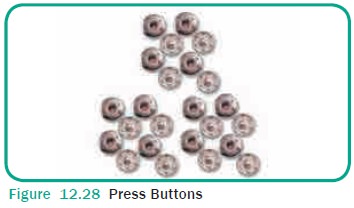
Hook and Eyes/Loops
Hook and Eye / loops are generally used in plackets. The hook is placed about 0.5 cm inside the finished edge on the wrong side of the overlap and the eye or loop comes on the underside of the placket. Hooks and eyes are used mostly in close fitting gar-ments like blouse. They also available in dif-ferent size, but circular in shape and is made out of metals. Hooks are metals with curved structure at the top with two parallel lines and finished with two circles at the bottom. Button hole stitches are made at the circles placing the hook on the garment to fix the hook onto the garment (Figure 12.29).
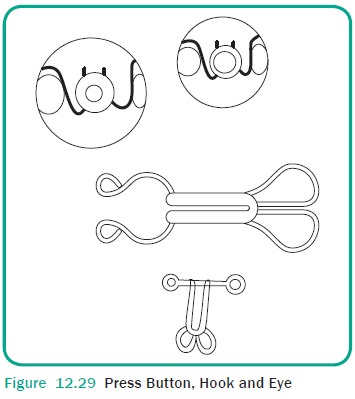
There are two types of eyes, namely metal and thread loops. The metal loops are sub divided as straight and “U” shaped. Both have circles at the end which is used as a mode to sew the eye to the garment with button hole stitches.
The loop eyes are also of two types, namely thread loops and fabric loops. Thread loops are made by sewing four to five straight stitches across the under lap to match the hook, using same colour thread as the garment. Button hole stitch is made on these strands. Fabric loops are made of strips of fabric matching the gar-ment. These strips are made into tube like structure, turned to push the seams inside, to give a neat loop. This strip is cut and placed on the required area and machined.
They form a loop on the placket open to extend outside to hold the but-ton on the opposite side of the garment. The size and width of the placket varies depending upon the garment and size of the button. These loops can be used for decoration also (Figure 12.30).
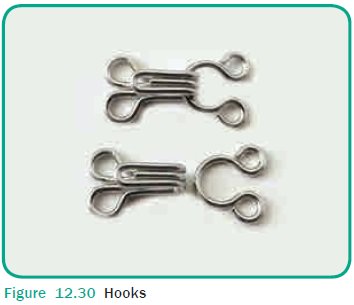
Buttons and Button Holes :
Buttons are both functional as well as decorative. They should be selected with care to suit the colour, design and tex-ture of the fabric and style of the garment. Decorative buttons vary in the form of glass, metal and plastic. Buttons have two or four holes. Mark the area where the button has to be sewen. Place the button and make a crosswise or vertical stitch connecting the four holes in the buttons. If the button is with a single hole in the wrong side of the button, place this on the right side of the garment, insert the nee-dle from back side, through the garment and then pass the thread into the hole in the back side of the button and then pick the needle back into the garment. This is repeated 3 to 4 times to fix the button. Buttonholes are slits cut in the garment to hold the buttons in place. It can be made vertically or horizontally with the button sitting exactly at the centre of the front line. The raw edges of the slit are finished with buttonhole stitch (Figure 12.31).
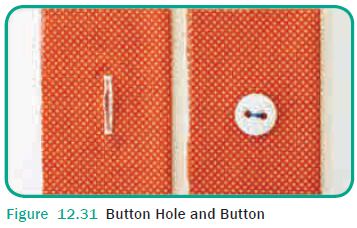
Zippers
Zippers come in a wide variety of colours, length and types. All zippers consists either a chain of metal or plastic teeth or a synthetic coil joined to a fabric tape made of cotton or cotton polyester blend.
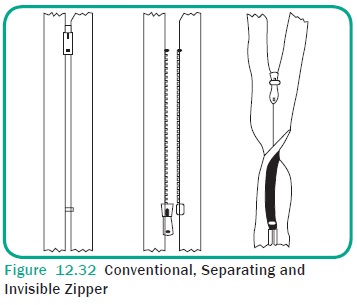
It has stoppers at the top or bottom which keep the sliders from running off the zip-per. There are three basic types of zip-pers available in the market. They are (Figure 12.32).
(i) Conventional Zipper: These are zippers with exposed teeth or chain and open at the top but are held together at the bottom.
(ii) Separating Zipper: They are open at both the top and the bottom and permit the zipper opening to sepa-rate completely as in jackets with opened fronts.
(iii) Invisible Zipper: They are the newest zippers and as the name implies they are not visible in the front as they disappear into the seam. They are mostly used in skirts and in dresses.
Other types of zippers include two way zipper, trouser zipper and decorative zipper.
Elastics
Elastics are used in areas where stretching is desired. There are different types of elas-tics available in the market and should be selected carefully according to the end use of the garment. It can be used as a casing or can be stitched directly on the garment. Some of the common types of elastic are-
(i) Braided Elastic: This elastic nar-rows when stretched and so used for casing.
(ii) Woven Elastic: The width of the elastic remains same even when stretched and so can be stitched directly to the garment or for casing.
(iii) Elastic Thread: It is also called Bobbin Elastic. It is very thin elastic covered with thread all around and is mostly used in bobbins for giving shirring effect.
(iv) Special Purpose Elastic: Special elastics are available for pajamas, lungies and swim-wear.
Tapes and Cords
Different types of tapes and cords are available which are both functional as well as decorative. They come in a variety of types, widths and colours and its selec-tion should depend mainly on its end use. Some of the common tapes available are-
(i) Seam Tape: Seam tapes are woven or lace tapes. They are used to finish hem and facing edges.
(ii) Binding Tape: Binding tapes are used for binding curved or straight edges and for casings.
(iii) Twill Tape: Twill tapes are mostly used for reinforcing seams.
(iv) Piping: Piping tapes are narrow bias strip of fabrics that can be inserted into a seam for decorative purpose.
(v) Hem Facing: Hem facing tapes are wide bias tape or lace which is used on facing hems and binding edges.
(vi) Ribbon Tape: Ribbon tapes are knit-ted bands which are stretchable and can be used to finish necklines, arm holes, sleeve, leg or waistline.
Velcro
Velcro is the commercial name for loop and hook fasteners. Velcro is a set of two tapes one with a looped napped surface and other with a hooked napped sur-face. When both the surfaces are pressed together they grip and remain locked until pulled apart. They are usually made of nylon and are available in meters. They are used on cuffs, plackets, mosquito nets and other such items. Velcro is popular in infant garments.
Buckles
Buckles are one of the most interesting types of fasteners. Buckles are available in plastic, iron, brass, steel and other such materials. The market is filled with a wide variety of shapes and sizes. There are two types of buckles – one with prongs which need eyelets to be attached with it and the other without prongs which do not need any eyelets. Eyelets can be ready- made, made out of metals or stitched made out of fabrics (Figure 12.33).
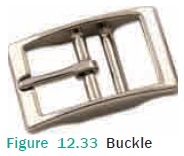
Related Topics